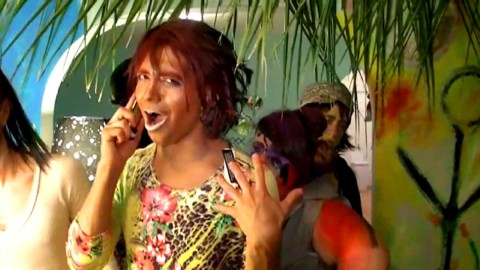Initially bewildering, Ryan Trecartin’s videos employ and manipulate a range of cultural references in campy, populous extravaganzas. A motley crew of wild, eccentric characters illustrates an exaggerated and humorous cross section of society. Their hysteria reaches absurd heights, yet it remains a reflection of the real world, drenched in images and information. Thus, the adoption of the term “hysterical realism” by curator Massimiliano Gioni effectively describes Trecartin’s work.
Born in Texas in 1981 and raised in rural Ohio, Trecartin holds a BFA from the Rhode Island School of Design (2004). His success came quickly and unexpectedly. Artist Sue de Beer saw one of his videos online and showed it to a curator at the New Museum. Subsequently, Trecartin’s work exploded onto the art scene. Over the past decade, he has lived and worked itinerantly with an evolving group of creative peers in cities across the country, including Providence, New Orleans, Philadelphia, Miami, and Los Angeles. He has had solo exhibitions at the Hammer Museum, Los Angeles; Wexner Center for the Arts, Columbus; Kunsthalle Wien, Vienna; The Power Plant, Toronto; and MoMA PS1, New York. His work has also been shown in international group exhibitions, including the 2006 Whitney Biennial; the 2008 Busan Biennale; the 2009 New Museum Triennial; and the 2013 Venice Biennale. Trecartin also contributed to and co-curated the 2015 New Museum Triennial, "Surround Audience."
The video that brought him public attention was A Family Finds Entertainment (2004). It stars Trecartin, who regularly appears his works. He plays Skippy, a foolish but terrifying boy who has locked himself in the bathroom of his home during a wild party. He eventually emerges to borrow money from his creepy parents. As Skippy goes outside, he encounters a filmmaker who wants to make a movie about him, but Skippy is hit by a car immediately. He apparently is killed, but a band’s music from a house party seems to raise him from the dead.
In I-Be Area (2007) Trecartin jumbles together stories with fast-moving, fast-talking characters to deal with a range of themes, including cloning, adoption, self-mediation, lifestyle options, virtual identities, and larger existential questions. Trecartin describes the end of the film, a chaotic scene in a wood shop, as “a conceptual part-cyber hybrid platform that obeys and functions within both laws of physics and virtual-nonlinear reality and potential in Web 2.0/ultra wiki communication malfunction liberation flow, add-on and debate presentation.”
Tommy Chat Just Emailed Me (2006) similarly suggests the manic digital hype of everyday life. The video short takes place inside an e-mail. Trecartin’s visualization of electronic communication features garishly colored scenes and isolated, yet highly stylized, characters that constantly communicate on the phone or online in nonsensical dialogue. The story moves from person to person like a browser surfing through web pages, ultimately demonstrating the rapid growth of technology and mass consumer culture.
Hence, storylines are loose, and not easily legible, constructions in Trecartin’s work. Referred to as “social science fiction,” they mainly serve as a basis for collaboration as he invites his friends to respond to his ideas and contribute to the creative process. Consequently, his videos often are compared to early John Waters, Paul McCarthy, or Mike Kelley and drag auteurs like Jack Smith and Tom Rubnitz. However, Trecartin cites music videos and counts the Disney Channel and Dirty Dancing among his important artistic inspirations. His works become uncanny reflections of youth culture, in which characters wear face paint in unnatural skin tones, avoid traditional gender roles, and blather on in an idiosyncratic dialect.
In fact, language is one of the most remarkable aspects of Trecartin's work. According to him, "I want people to see that I'm passionate about linguistics, especially within the medium of movie-making.” His distinctive usage, despite seeming ad-libbed, is highly scripted in his signature deranged jargon, which Randy Kennedy calls “phrases that sound like something you might have heard before, on television or the Web, but haven’t.” Characters speak in fragmented sound bites, spouting phrases like "identity tourism," "personality shares," and "intellectual sexaganda.” They use evocative non sequiturs that are not only amusing but also sum up life in the hyper-mediated, hyper-aware, hyper–self-reflexive YouTube Age, such as "I am tired of seeing him around my peripheral lifestyle options" and "She is always so automatic and un-re-writeable."
These few lines of dialogue come from the video Sibling Topics (section A) (2009), which adopts a narrative and style that are more cinematic and seemingly straightforward than Trecartin’s other works. Family is the central theme as the video begins with a pregnant character, Carryon Ova, who creates a time-capsule video message to her unborn quadruplets, foretelling her own death at the hands of her husband. Trecartin plays the quadruplet sisters named Ceader, Britt, Adobe, and Deno, the boundaries of whom are indistinct. It is difficult to tell where one ends and the other begins.
The sisters' pursuits of love, identity, et cetera lead them on a series of adventures, called premises—personal situations sold through identity-tourism agencies with predetermined tones, terms, and trajectories. Eventually a friend, Mass Major, calls the agency of the sisters into question. As a seeming message for the media age, Kevin McGarry writes, the sisters’ experiences suggest “preconceived control of a scene from one's life is more an expression of weakness than mastery and of inherent doubt in one's ability to direct the action of a spontaneous encounter.” To do so, one must accept and face reality. —Kanitra Fletcher

